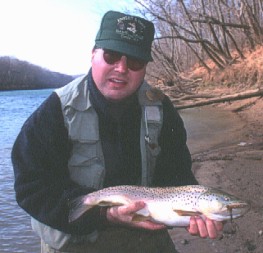
That kind of trout fishing may have its place, but give me the monster trout with shoulders - fish that live deep in brushpiles and eat stocker rainbows for lunch.
While light lines and tiny rods work on some streams, one needs serious equipment to tackle the big trout of the Cumberland River system. In an area where one is apt to hook into a 20-30 pound striper, beefy terminal tackle and a different attitude are in order
1. Big Bait = Big Fish: No tournament fisherman worth his salt ever sets out without a few baits of enormous size. I've seen worm fishers with rubber worms over 13 inches long. I've seen them effectively fish crankbaits 10 inches long. When the action is good, but the fish are small, the pros will often turn to the monster baits to entice a real trophy up.
Fly fishers could benefit by sizing up a few flies. Used to fishing stonefly nymphs in size 6? Try a #4 or #2. You might be surprised at what it conjures up. Streamers in the 4-6 inch range are not out of place either. In high or murky water, the extra size makes your fly more visible.
2. Multiple Rigs: Most bass fishers have between 3 and 6 rods rigged up with different lures at any time. See a fish close by on the surface? Out comes the Skitter pop bug. See a fish in the jumps 70 yards away? Pull out the heavy spoon and long rod. A change up is only a few seconds away.
I've seen too many fly fishermen spend the better part of a hatch re rigging and re tying leaders. Heck, I've been guilty of it myself. The answer is to keep 2- 3 rods ready at any time. Granted this is a bit of a problem when wading, but should pose no problem for boat fishers.
I, myself, try to keep a heavy rod ready with a sinktip for fishing big streamers. My other rod is a long 6 weight I use for indicator nymphing. Both the sinktip and indicator rig are time consuming to swap out. Having them both constantly at the ready ensures I can change up in a moment's notice.
Keeping these tricks of the professional bass angler in mind, a fly rod trout fisherman can up his chances of success on his next Cumberland tailwater outing.
I'll have more "Bass fishing for larger trout" hints in the next installment.
Copyright © 1998 - thisyear The Buckeye United Fly Fishers, Inc. Cincinnati, OH 45242
The Buckeye United Fly Fishers, Inc is a non-profit corporation organized under section 501(c)(3) of the Internal Revenue Code, incorporated in the State of Ohio for the preservation, conservation and wise use of our fishing waters and game fish; and to assist in the protection and improvement of our natural resources